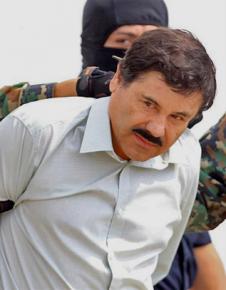No escape from drug war violence
looks beyond the media's sensationalized coverage of the prison break in Mexico to document the factors that are really driving the violence and tragedy.
HOW DID Joaquín "El Chapo" Guzmán Loera, the world's most infamous drug lord, escape from a maximum-security prison in Mexico for a second time? The answer: Corrupt prison officials, cold, hard cash...and a tunnel.
Now, Mexican and American officials are expressing outrage and looking for people to blame after Guzmán, the head of the Sinaloa drug cartel, broke out of the Altiplano Federal Penitentiary just outside of Mexico City.
Guzmán's capture last year was as dramatic as his escape this year, and the occasion for a lot of boasting. In a James Bond-style chase that included Blackhawk helicopters, a drone, a bathtub trapdoor, a battered-down reinforced steel door, and a chase through sewer tunnels, the Mexican Marines finally got their man.
But earlier this month, El Chapo escaped through a mile-long tunnel that opened below the shower in his cell and ended underneath a safe house. A widespread manhunt was launched and a reward of $3.8 million offered. The prison director has been fired, and dozens of correctional officers have been questioned and face possible charges.

Guzmán's first escape came in 2001 after he served eight years in the Puente Grande prison in the state of Jalisco. It was widely reported at the time that he left the prison hidden in a laundry basket, but according to journalist Anabel Hernández, Guzmán bribed high-level prison officials and was most likely escorted out of Puente Grande by guards. Hernandez published a book about the Sinaloa Cartel called Narcoland: The Mexican Drug Lords and Their Godfathers that documents El Chapo's getaway.
Likewise, the media's sensationalized coverage of this year's escape skips over the more everyday factors. As Laura Carlsen, director of the Center for International Studies' Americas Program, explained in an interview:
This wasn't the Great Escape. It was a sophisticated exit, but one that depended more on government complicity than on cunning. Someone high up wanted El Chapo on the outside for reasons that now we can only surmise...There was something fishy about his capture, and there is something even fishier about his escape.
GUZMÁN IS a billionaire businessman who has been trafficking in drugs for over two decades. His success has only been possible because the Sinaloa Cartel has ties to the Mexican deep state and the military. This cozy relationship guarantees that profits from the illicit drug trade are shared by Guzmán and the government officials he generously bribes.
Mainstream reporting of Guzmán's escape focused obsessively on the construction of the tunnel and its contents, and followed the talking points of the Drug Enforcement Administration (DEA), whose agents, active and retired, were quoted extensively in article after article. Their unsurprising conclusion was that El Chapo's getaway was a "humiliating embarrassment" to the Mexican government and "adds to the strains" between the U.S. and Mexico.
Meanwhile, there was no questioning in the media's coverage of the drug war itself and the fact that prohibition has been an utter failure. There was no mention of the gruesome toll that the U.S. "war on drugs" has taken on the Mexican people--an estimated 100,000 people have died in drug war-related violence and 20,000 have vanished. Mexico is so drenched in blood and violence that hundreds of thousands of Mexicans have been forced to flee their homes.
When Enrique Peña Nieto was elected to the presidency in 2012, he declared, "My government will continue mounting a real fight against the trafficking of marijuana and all other drugs." He promised to cut in half the number of kidnappings and murders in Mexico.
That promise hasn't been kept--instead, violence has surged through the country, culminating in a brazen attack on student teachers and the kidnapping of 43 of them in Ayotzinapa last year. It is believed that local police handed the students over to drug traffickers, who murdered them and incinerated their bodies.
But even this sickening crime didn't result in the U.S. suspending military aid to Mexican law enforcement organizations, via the Mérida Initiative. Since 2007, the Mexican government has received over $2.3 billion in aid through the program, ostensibly to fight the drug war. Despite calls from human rights organizations on both sides of the border, President Obama said he would continue the aid "indefinitely."
Mexico has lost the drug war. Two months ago, the government launched an assault on the Nuevo Generación and Los Cuinis cartels in the state of Jalisco. They fought back in a spectacular show of force and firepower. According to one account: "Within hours, the cartels mobilized more than 500 men in coordinated counterattacks, shooting down a military helicopter, burning 11 banks, five gas stations and 36 buses, killing 15 people and injuring 20 others. The criminals also blocked 12 highways affecting the central states of Jalisco, Colima, Guanajuato, and Michoacán."
The reality is these battles in the drug war have virtually no impact on price, availability or consumption of drugs--nor on the everyday violence that accompanies the drug trade.
El Chapo is a product of prohibition in the same way that the American gangster Al Capone was. It doesn't matter if drug kingpins are put in prison, escape from prison, are captured or are killed. As long as drugs remain illegal and are worth more than gold, the violence, corruption and crimes against humanity will go on.
As Carlsen concluded in the interview:
When you look at how the U.S.-sponsored drug war in Mexico works--as a series of moves to administer, rather than stop the illegal business--it is unsurprising that even figures as high-profile as El Chapo Guzmán can be manipulated to assure that the billions made off U.S. prohibition continue to pour into the pockets of the most powerful.


